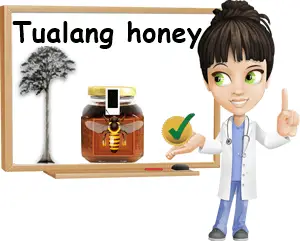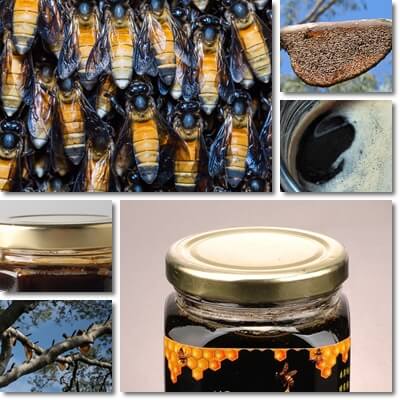Tualang honey is a special and relatively rare variety of honey produced in the tropical and subtropical forests of south and southeast Asia. People call tualang honey the new manuka honey due to its competitive therapeutic properties owed to a higher content of phenolics, flavonoids and other bioactive components, as well as greater variety of pollen sources. The polyfloral jungle honey is quite particular in its appearance as it can range in color from a rich golden-brown to dark brown, red and black.
Both color and taste profile vary with season, region and nectar sources in the honey.
Where does tualang honey come from?
Tualang honey is a variety of honey native to the jungle areas of south and southeast Asia, hence the reason it’s also commonly referred to as a ‘jungle honey’. The honey is produced by a different species of honeybee, Apis dorsata, also commonly called the giant honeybee. The giant honeybee builds nests hanging from the branches of tualang trees (Koompassia excelsa), a species of tree in the Fabaceae family related to beans, peas, alfalfa and peanuts.
Also known as tapang, mangaris or bangris, the tree species reaches incredible heights of over 80 meters and towers the jungle canopy, providing a relatively safe haven for the giant Asian honeybee to build its nest.

What kind of honey is tualang honey?
Tualang honey is a variety of polyfloral honey, also called a multifloral honey. That is, it’s made from nectar collected from multiple species of flowering plants, including tualang tree flowers. A single sample of tualang honey may contain hundreds of nectar (and pollen) sources which is an aspect believed to contribute greatly to its therapeutic activity and medicinal benefits.
At least some of the flower sources that serve as food for the giant Asian honeybee are unique to the respective forests and hold undiscovered therapeutic properties that can transform the honey into a potent medicinal agent.
Tualang honey is a variety of flower or floral honey because it’s made from flower nectar and, to a lesser extent, pollen. As opposed to honeydew honey, also called forest honey, which is made from the sweet secretions of insects such as aphids that feed on tree sap (e.g. Halkidiki Greek pine honey, hickory honey, Romanian and Bulgarian mana honey). And because the flowers that provide the nectar and pollen to the honeybees are wildflowers, occurring naturally in the wild, tualang honey is also referred to as a wildflower honey.
What else is tualang honey called?
Because the nectar sourced by the honey bees to make their honey comes from flowering plants in the wild, tualang honey is also classified as a wild honey or more specifically, jungle honey or rainforest honey. Depending on the country where it comes from, attributes such as country name may be added to the honey name e.g. Malaysian tualang honey, Malaysian wild tualang honey, Indonesian tualang honey etc. And because the giant honey bee species that produces the honey, Apis dorsata, is undomesticated, tualang honey is also called a wild honeybee honey.

What is tualang honey?
Despite being considered as one type or one variety of honey, tualang honey is not quite one variety. By definition, tualang honey is honey collected from the honeycombs of the giant Asian honeybee, found hanging on the branches of tualang trees all over south and southeast Asia. The honeybees don’t feed on just one type of flower and don’t have major crops of the same flowering plants available, so their diets are quite diverse.
Any flowering plant species can serve as food for the giant Asian honeybee and that’s a lot of variety. Depending on the country, forest region, season and year, different flowers are blooming so there can be many nectar and pollen contributions from hundreds of species to what is generically called tualang honey.
Types of tualang honey
There are actually 3 major types of tualang honey which look and taste differently, and have a range of therapeutic properties:
- Yellow tualang honey
- Red tualang honey
- Black tualang honey
What does tualang honey look like?
Yellow or gold tualang honey is actually a medium golden-brown color. Red tualang honey is a darker amber color with strong red undertones. Black tualang honey is actually a very dark amber color – it only appears black while it’s settled in the jar, however, as soon as you drip it from a honey dripper or spoon, you can notice it’s actually very dark amber. The honeycomb that contains the honey is large and paler yellow which makes for an interest contrast with the often darker honey.
White foam on top of tualang honey
You might noticed your tualang honey has some whitish foam on top. The foam tends to occur in raw, unfiltered tualang honey that has not been heat-processed (and not just tualang). Typically, a layer of white or whitish foam on top of honey indicates a honey of the highest quality, as close as possible to its natural state. Foam on top of honey can also be caused by agitation of the honey which can occur if the honey is transferred from one larger container to a smaller one like a jar.
Foam can potentially predispose to crystallization, a natural processes that can change the consistency of the honey and harden it over time. In rare cases, honey with foam can ferment, but the process is usually aided by improper storage (high heat) and contamination with various organic particles.
What does tualang honey taste like?
Different types of tualang honey taste differently. The taste may vary from year to year, season to season, region and flora of the region where the honey is produced – one sample of tualang honey may contain hundreds of different floral sources. For the most part, tualang honey is a slightly stronger flavored honey, with a medium taste intensity and mild sweetness. It has molasses flavors and faint, sweet black licorice notes complimented by a pleasant bitterness.
There are multiple distinct flavors to the honey, unique to the flower nectars that make it. The scent is light and floral and the consistency somewhat watery, even bubbly. If the honey is unfiltered, it may contain bigger air bubbles and various particles that may alter its smooth texture (e.g. pollen particles, honeycomb particles).
What is tualang honey good for?
Preliminary research shows tualang honey has medicinal properties comparable to those of the famous manuka honey. Tualang honey producers are currently developing their own grading system to asses the therapeutic activity of their honey and be able to provide a certified product to consumers.
Studies indicate tualang honey has strong antibacterial and anti-inflammatory properties, antitumor, antimutagenic, anti-proliferative and apoptosis-inducing effects, as well as antidiabetic potential. Tualang honey holds some degree of activity against gram-negative bacteria strains commonly present in burn wounds and may hold indication for use in wound healing and healing of burns.
Where to buy tualang honey?
Unless you’re travelling to a remote village in south and southeast Asia and venturing into the jungle to climb towering tualang trees and risking being stung by large bees to get some of their delicious honey, then Amazon and other online shops is where you can get the honey. Make sure to buy tualang honey with some sort of certification, from a reputable vendor, and go for raw, unfiltered, unpasteurized honey.
